1. The Church of St.Mary and The Belfry of St. Mary's Church |
|
| |
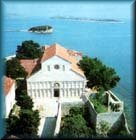
One of the most important monuments is the 12th century Church f St. Mary. The Church, formerly the cathedral of Rab and now the parish church, was built in Romanesque style as an aisled basilica with three apses. Originally, in the 8th century, this was the site of another church few traces of which are extant. The church was consecrated in 1175 by pope Alexander III, who visited Rab while travelling from Zadar to Venice. It was repaired, modified and extended several times, and much of its original appearance is now lost.
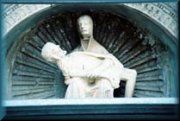 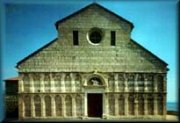 |
| |
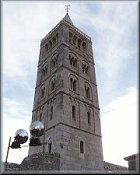
The belfry of the St. Mary's church, 26 metres high, is one of the most beautiful structures of this kind in the Adriatic regions. Its construction started in the 12th century and was completed in the early 13th century. The belfry consist of the ground story and the four stories, and ends at the top with an octagonal pyramid built in the 15th century instead of the former, rectangular pyramid destroyed by lightning. The top story has a window (aperture) with four beautiful arches. Each successive story - going downwards - has one arch less. A cross with five steeple balls surmounts the spire.
|
|
|
|
| |
2. The Nunnery of St. Antony
3. The Church of St. Andrew
4. The Church of St. Justine
5. The Ruines of the Church and Convent of the St. John the Evangelist |
|
| |
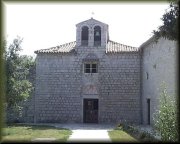
Magdalena Budrusic, noblewoman from Mainland, who fled the Turks and sought refuge on the island, founded the Nunnery of St. Antony at the southeaster end of the peninsula, in 1499. A small church of the older date is situated next to the nunnery. |
 The church of St. Andrew
The church of St. Andrew is close to the main belfry. It was built fir Matej, the Bishop of Rab in 1020. Next to the church, built as an aisled basilica, is a Benedictines nunnery. The church contains several interesting and valuable details. The belfry of St. Andrew is the oldest of the four Rab belfries - it was built as early as 1181.
|
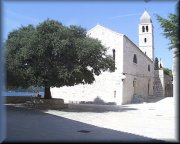 The church of St. Justine at the western end of Freedom Square was built in 1573-1578 together with the Benedictine nunnery. Both were built by the commoners, the nunnery was abolished in 1808. Among the several outstanding paintings in the church the most valuable is the Death of St. Joseph, work of the 16th century Venetian school. The belfry of the church was built about a hundred years later; although it is the «youngest» of the four Rab belfries, it is perfectly integrated with the appearance of the other belfries. The church of St. Justine at the western end of Freedom Square was built in 1573-1578 together with the Benedictine nunnery. Both were built by the commoners, the nunnery was abolished in 1808. Among the several outstanding paintings in the church the most valuable is the Death of St. Joseph, work of the 16th century Venetian school. The belfry of the church was built about a hundred years later; although it is the «youngest» of the four Rab belfries, it is perfectly integrated with the appearance of the other belfries.
|
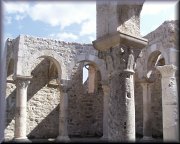
Ruins of the Church and Convent of St. John the Evangelist. The church a true architectural masterpiece, and the convent are no longer extend; only the 12th century belfry, resembling completely has survived. The church and the convent were probably built in the 10th and 11th centuries, when the Benedictines came to Rab. Both the buildings fell to ruin in the late 19th century, leaving us only a few remains of the beautiful constructions.
|
|
|
| |
6.
The Monastery of St. Euphemia |
|
| |
|
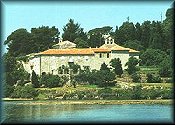 The Monastery of St. Euphemia is situated at the end of the bay bearing the same name, in the area of Kampor. The complex includes two churches; the older, small Church of St. Euphemia, dates from tge 13th century, but it has almost entirely lost its original appearance. The Church of St. Bernardine is small Gothic basilica, but 17th and 18th century reconstructions, substituted semicircular Baroque windows for the Gothic ones, The church contains a number a valuable paintings, the crucifix, candelabra; a large well and sidewise, several inscriptions and a beautiful sarcophagus, can be admired in the cloister. The Monastery of St. Euphemia is situated at the end of the bay bearing the same name, in the area of Kampor. The complex includes two churches; the older, small Church of St. Euphemia, dates from tge 13th century, but it has almost entirely lost its original appearance. The Church of St. Bernardine is small Gothic basilica, but 17th and 18th century reconstructions, substituted semicircular Baroque windows for the Gothic ones, The church contains a number a valuable paintings, the crucifix, candelabra; a large well and sidewise, several inscriptions and a beautiful sarcophagus, can be admired in the cloister.
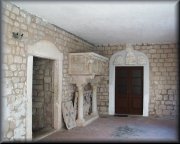
The small monastery museum displays a number of interesting cottage industry products, works of sacred art, valuable old books including five famous hymnals on parchment, a number of objects found on island and belonging to different historical periods, and a valuable coin collection.
|
|
|
| |
7.
The Church of St.Peter |
|
| |
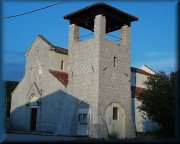 The church of St. Peter at Supetarska Draga is the oldest preserved church on the island (it was built in 1059). Drago, bishop of Rab, granted it to the Benedictines, and the deed of donation was also confirmed by King Petar Kresimir IV in 1070. The church of St. Peter at Supetarska Draga is the oldest preserved church on the island (it was built in 1059). Drago, bishop of Rab, granted it to the Benedictines, and the deed of donation was also confirmed by King Petar Kresimir IV in 1070.
By the church are the ruins of the former Benedictine abbey. It was built as simple aisled basilica, with a plain facade and a simple but beautiful marble doorway; in the church there are several valuable paintings and other objects.
|
|
| |
8.
The Dominis Nimira Palace |
|
| |
 The Dominis-Nimira Palace. It was built in the 15th century in the Renaissance style with some Venetian Gothic features. Its most outstanding parts are the windows, laid out asymmetrically but beautifully worked, and the doorway with the escutcheon of the Dominis Family. The Dominis-Nimira Palace. It was built in the 15th century in the Renaissance style with some Venetian Gothic features. Its most outstanding parts are the windows, laid out asymmetrically but beautifully worked, and the doorway with the escutcheon of the Dominis Family.
 Near this palace is the magnificent doorway of the once beautiful palace of the noble Nimir family. The attractive Nimira ascutcheon can be seen in the tympanum of the doorway; somewhat above are remains of the beautiful balustrade on the terrace overlooking the courtyard. The doorways admit to a beautiful courtyard containing architectural fragments, while the adjoins garden accommodates the Grands restaurants. Near this palace is the magnificent doorway of the once beautiful palace of the noble Nimir family. The attractive Nimira ascutcheon can be seen in the tympanum of the doorway; somewhat above are remains of the beautiful balustrade on the terrace overlooking the courtyard. The doorways admit to a beautiful courtyard containing architectural fragments, while the adjoins garden accommodates the Grands restaurants.
|
| |
|
|
|
| |
9. The Duke's Palace |
|
| |
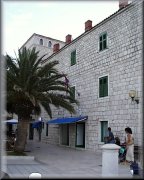 The Duke's Palace is another of Rab's most outstanding monuments. This is, in fact, a complex of several palaces built in different times, dominated by the high rectangular tower, with beautiful Venetian Gothic and Renaissance windows. The constructions of the palace started as early as the 13th century, but its most characteristic parts date from the 15th and 16th centuries. The Duke's Palace is another of Rab's most outstanding monuments. This is, in fact, a complex of several palaces built in different times, dominated by the high rectangular tower, with beautiful Venetian Gothic and Renaissance windows. The constructions of the palace started as early as the 13th century, but its most characteristic parts date from the 15th and 16th centuries.

Above the entrance to the vaulted atrium are the remains of an old balcony, supported by three brackets with lion's head. Proclamations were read from this spot.
|
|
| |
10.
City's Loggia |
|
| |
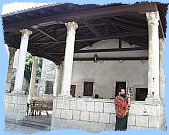
From 1509, when it was built, to the fall of the Venetian Republic in 1797, the centre of public life in the town was the beautiful Loggia, a square Renaissance buildings with attractive stone columns.

Next to the Loggia is the small Church of the Holy Spirit, where the town councillors used to meet before important sessions, and where important documents were signed. |
|
|
| |
11. Komrcar Park |
|
| |
|
|
